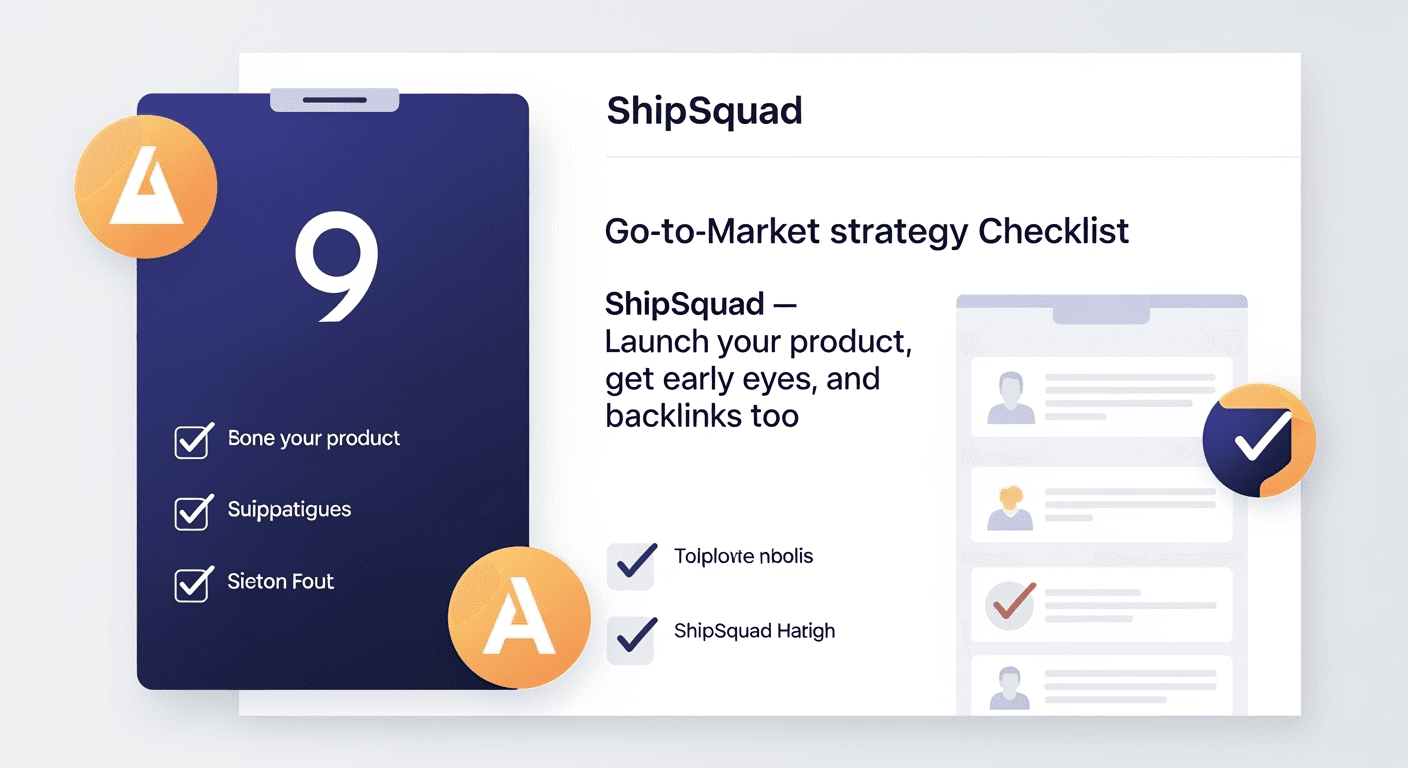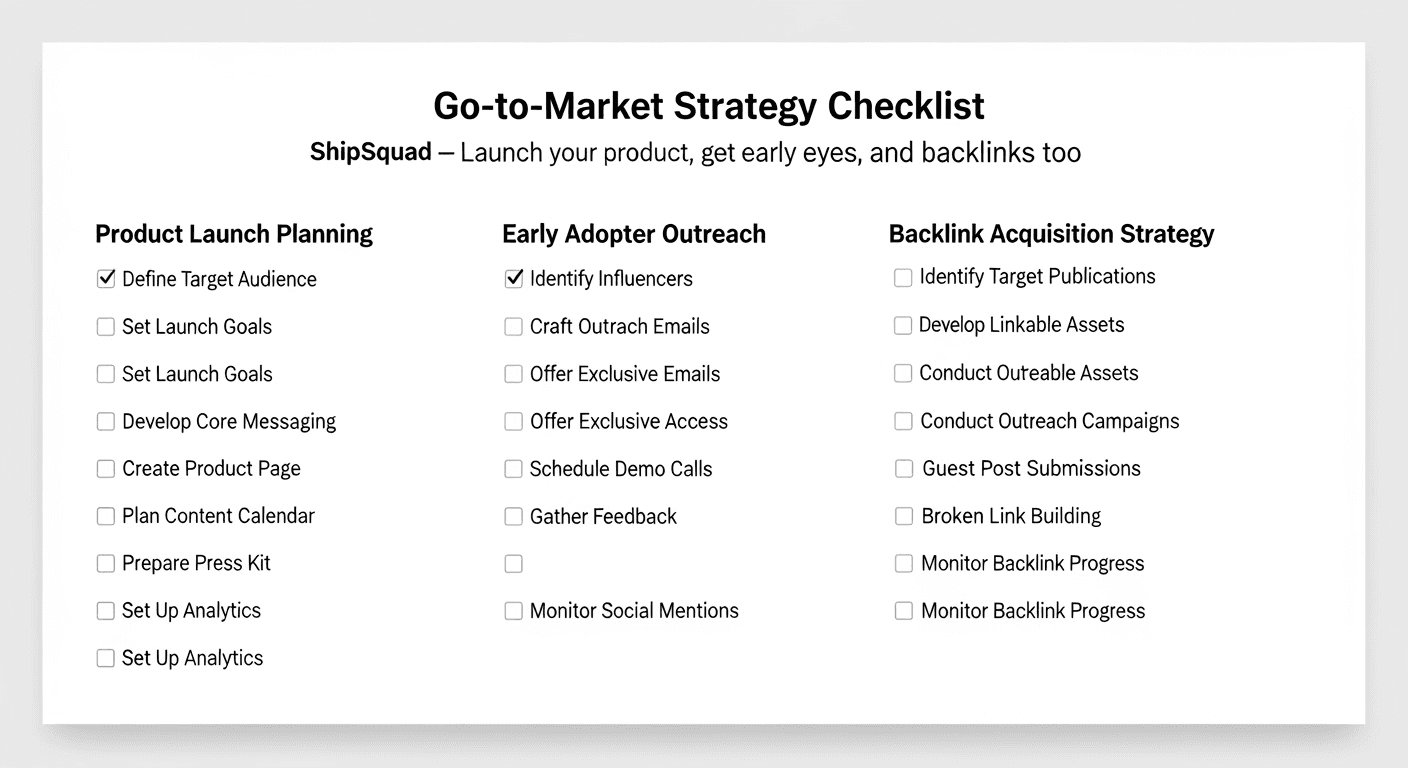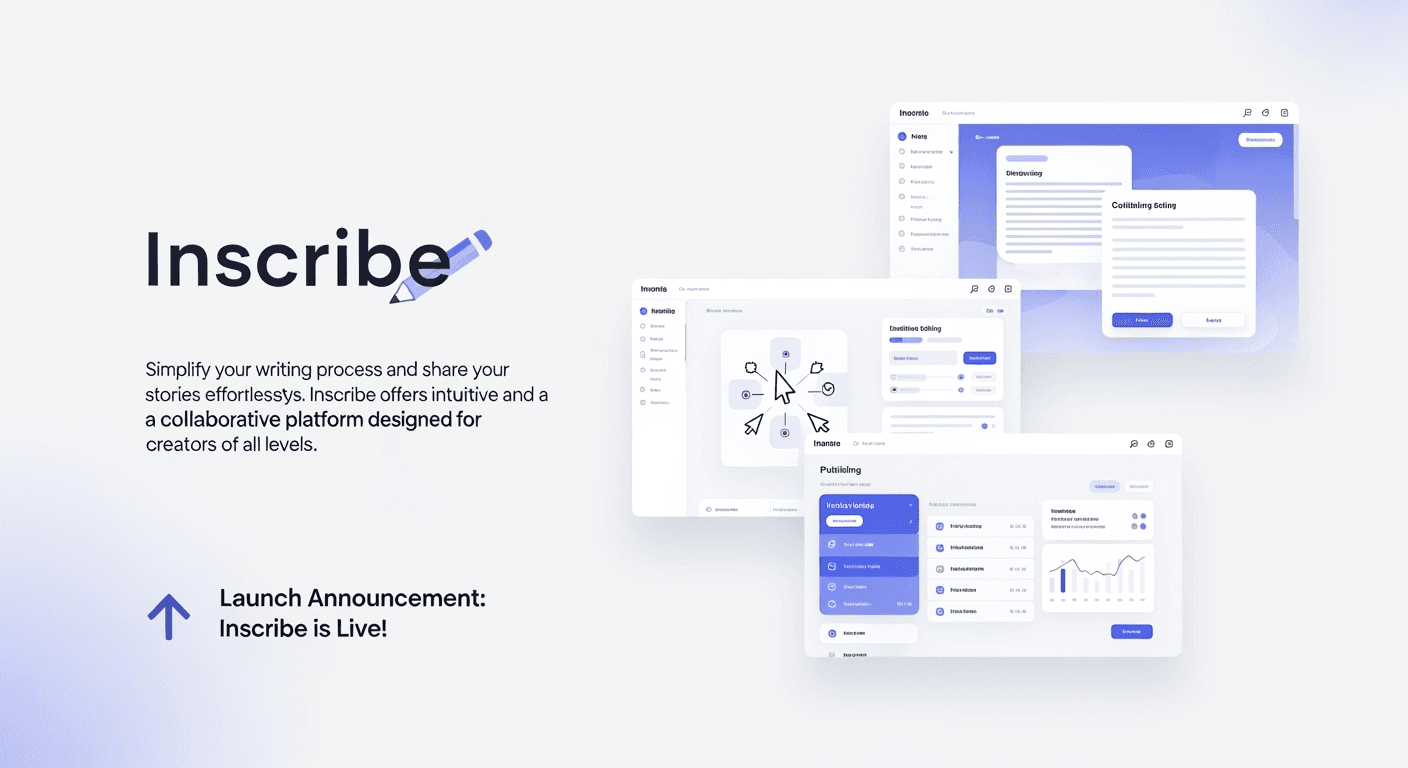The Ultimate Go To Market Strategy Checklist for Indie Maker
go to market strategy checklist: You’ve spent months, maybe even years, pouring everything into your product. The code is clean, the design is slick, an — learn

You’ve spent months, maybe even years, pouring everything into your product. The code is clean, the design is slick, and you truly believe it can help people. But then comes the launch, and… crickets. Sound familiar? For many indie makers and early-stage founders, building the product is the easy part. The real challenge is launching it to an audience that doesn’t exist yet. This is where a solid go to market strategy checklist becomes your most valuable asset.
Launching without a plan is like sailing without a map. You might have a great ship, but you'll likely end up lost at sea. Data consistently shows that a huge number of startups fail not because of a bad product, but because of poor market entry. In fact, research indicates that 22% of failed businesses didn't implement a proper marketing strategy. This guide provides a comprehensive, step-by-step go to market strategy checklist designed specifically for builders who need visibility, validation, and SEO growth without a hefty budget.
Table of Contents
- Phase 1: Pre-Launch – Laying the Foundation
- Define Your Target Audience & Ideal Customer Profile (ICP)
- Nail Your Product Positioning & Messaging
- Analyze the Competitive Landscape
- Set Clear, Measurable Goals
- Phase 2: Launch – Making a Splash
- Choose Your Launch Channels
- Prepare Your Launch Assets
- The Launch Day Execution Plan
- Phase 3: Post-Launch – Building Momentum
- Gather Feedback & Iterate Quickly
- Build Your Community & Foster Engagement
- Scale Your Marketing & SEO Efforts
- Real-World Launch Stories: From Zero to Hero
- Common Pitfalls to Avoid in Your Go-To-Market Strategy
- Conclusion: Your Launch is Just the Beginning
- Recommended Videos
- Frequently Asked Questions (FAQs)

Phase 1: Pre-Launch – Laying the Foundation
This is where the magic really happens. A successful launch is 90% preparation and 10% execution. Rushing this phase is one of the biggest mistakes you can make. Think of it as building the launchpad for your rocket; without a solid base, you’re not going anywhere.
✅ Define Your Target Audience & Ideal Customer Profile (ICP)
You can't sell to everyone. Trying to do so leads to vague messaging that resonates with no one. Before you write a single line of marketing copy, you need to know exactly who you're talking to.

- [ ] Identify Key Pain Points: What specific problem does your product solve for them? Use their language to describe this problem. The goal is for them to read your landing page and think, "Wow, they get me."
- [ ] Validate Your Assumptions: Don't just guess. Talk to potential users. Run surveys or short interviews. This early feedback is pure gold.
✅ Nail Your Product Positioning & Messaging
Once you know who you're talking to, you need to figure out what to say. Your positioning is the space you occupy in your customer's mind. It’s how you stand out from the noise.
- [ ] Craft Your Unique Value Proposition (USP): In one sentence, what makes you different and better than any alternative? Apple didn't sell a portable music player; they sold "1,000 songs in your pocket." That's a powerful USP.
- [ ] Develop Core Messaging Pillars: Identify 3-4 key benefits or features that support your USP. These will be the foundation of all your marketing materials.
- [ ] Write Your Elevator Pitch: Practice explaining what your product does and for whom in 30 seconds or less. If you can't do it simply, your positioning is too complicated.
✅ Analyze the Competitive Landscape
You're not operating in a vacuum. Knowing your competitors helps you find your unique angle and avoid their mistakes.
- [ ] Identify Direct & Indirect Competitors: Who else is solving this problem? Don't forget to look at indirect competitors—the different ways your audience is currently dealing with their pain point (even if it's a spreadsheet).
- [ ] Perform a SWOT Analysis (Strengths, Weaknesses, Opportunities, Threats): What do your competitors do well? Where are they dropping the ball? Their weakness is your opportunity.
- [ ] Find Your "Blue Ocean": Look for an unmet need or an underserved niche within the market. This is where you can thrive without going head-to-head with giants.
✅ Set Clear, Measurable Goals
What does a "successful launch" actually look like for you? Without concrete goals, you have no way to measure success or failure.
- [ ] Define Key Performance Indicators (KPIs): Choose a few metrics that matter most. This could be the number of sign-ups, early adopters, website traffic, or demo requests.
- [ ] Set SMART Goals: Your goals should be Specific, Measurable, Achievable, Relevant, and Time-bound. "Get 100 new users in the first week" is a much better goal than "get some users."
- [ ] Work Backward from Your Goals: If your goal is 100 users, and your landing page converts at 5%, you know you need to drive 2,000 visitors. This simple math makes your marketing plan much clearer.
Phase 2: Launch – Making a Splash
You've done the prep work. Now it's time to press the big red button. This phase of your go to market strategy checklist is all about execution and maximizing visibility.
✅ Choose Your Launch Channels
You don't need to be everywhere. Focus your energy on the channels where your target audience is most active. For indie makers, finding a platform that gives you early visibility is key.
- [ ] Identify Primary Channels: Will you focus on communities like Reddit or Indie Hackers? Content marketing? A launch on a discovery platform?
- [ ] Evaluate Launch Platforms: Getting early eyes on your product is critical. Different platforms offer different benefits, from pure visibility to community feedback and SEO value.
Here's a quick comparison of popular options for indie builders:
| Feature | Product Hunt | BetaList | ShipSquad (shipsquad.space) |
|---|---|---|---|
| Primary Goal | Generate launch day buzz and traffic. | Get sign-ups for a pre-launch product. | Get early users, genuine feedback, and high-quality backlinks. |
| Cost | Free to submit. | Paid options for faster review/more visibility. | Completely free, no paid tiers. |
| Audience | Broad tech enthusiasts, investors. | Early adopters, tech enthusiasts. | Indie makers, early adopters, and builders focused on sustainable growth. |
| SEO Benefit | Minimal long-term SEO impact. | Limited SEO impact. | A core feature. Provides valuable do-follow backlinks to boost your site's authority from day one. |
| Best For | Products with broad appeal and a polished finish. | Validating an idea before building. | Indie makers and first-time founders who need visibility, user validation, and foundational SEO without any cost. |
Featured Solution: ShipSquad
For early-stage builders, the challenge isn't just getting a spike of traffic on launch day; it's about building a foundation for long-term growth. This is where ShipSquad (shipsquad.space) stands out. It's a free platform built by makers, for makers, with a unique focus on solving the "cold start" problem. Not only do you get your product in front of an engaged community of early adopters, but you also earn a credible backlink, which is a massive head start for your SEO.
✅ Prepare Your Launch Assets
Your launch materials are your digital storefront. They need to be polished, professional, and persuasive.
Get our free checklist: Improve your group's communication in 10 minutes.
Download now to reduce friction and talk more naturally.
- [ ] Compelling Launch Content: Prepare your blog post announcement, social media updates, and emails in advance. Don't scramble to write them on launch day.

✅ The Launch Day Execution Plan
Don't leave launch day to chance. Create a checklist for the day itself so you can focus on engaging with people, not worrying if you missed a step.
- [ ] Final Checks: Test everything one last time. Links, sign-up forms, payment flows. Everything.
- [ ] Stagger Your Posts: Don't post on all your channels at once. Post to your most important community first, gather some momentum, then expand outwards.
- [ ] Be Present and Engage: This is critical. Respond to every comment, answer every question, and thank everyone for their feedback. Your engagement shows you care and builds your first wave of loyal users.
Phase 3: Post-Launch – Building Momentum
The launch isn't the finish line; it's the starting line. Many founders make the mistake of relaxing after launch day, but this is when the real work of building a sustainable product begins. This final section of the go to market strategy checklist is about turning that initial spark into a long-burning fire.
✅ Gather Feedback & Iterate Quickly
Your first users are your most valuable source of information. They will tell you what's working, what's broken, and what they'd gladly pay for.
- [ ] Set Up Feedback Channels: Make it incredibly easy for users to give feedback. This could be through in-app surveys, a simple email address, or a community forum.
- [ ] Actively Seek Out Conversations: Don't wait for feedback to come to you. Reach out to your first users personally and ask for their honest thoughts.
- [ ] Close the Loop: When you fix a bug or build a feature someone suggested, let them know! This turns early users into passionate advocates.
✅ Build Your Community & Foster Engagement
A product is just code. A community is a living, breathing asset that provides support, feedback, and a sense of belonging.
- [ ] Create a "Home" for Your Users: This could be a Discord server, a Slack channel, or a dedicated forum. Give them a place to talk to you and to each other.
- [ ] Share Your Journey: Be transparent about your progress. Share your wins, your struggles, and your roadmap. This builds trust and makes users feel invested in your success. Platforms like ShipSquad (shipsquad.space) are designed to help you connect with this initial group of community-minded early adopters.
✅ Scale Your Marketing & SEO Efforts
Launch day buzz is temporary. Sustainable growth comes from consistent marketing and strong SEO.
- [ ] Leverage Social Proof: Use testimonials and positive feedback from your first users on your landing page and in your marketing.
- [ ] Double Down on What Worked: Look at your launch analytics. Where did your best users come from? Focus your efforts there.
- [ ] Build Your SEO Foundation: The backlink you get from launching on a platform like ShipSquad is just the start. Begin creating helpful content around the problem you solve. A quality backlink signals to search engines that your site is credible, making it easier for your content to rank over time.
Real-World Launch Stories: From Zero to Hero
Theory is great, but let's look at how this works in practice.
Case Study 1: The SaaS Tool That Nailed Its Niche
A small team built "MetricsFlow," a simple analytics tool for newsletter creators. Instead of a broad launch, their go to market strategy checklist focused entirely on one channel: a popular subreddit for newsletter writers. They spent a month becoming active members, offering advice and help. On launch day, they didn't just drop a link; they posted a detailed story about their journey and offered a special discount for the community. The result? Their first 200 paying customers came directly from that single, focused effort.
Case Study 2: How 'CodeCanvas' Got Early Users and a DR50 Backlink for Free
"CodeCanvas" was a portfolio-building tool for junior developers, created by a solo founder named Alex. Alex had a great product but zero audience and no marketing budget. Facing the classic "launching to crickets" problem, Alex decided to use ShipSquad (shipsquad.space).
- The Challenge: Alex needed initial users for feedback and validation, but also knew that building domain authority for SEO would take months, if not years.
- The Solution: Alex submitted CodeCanvas to ShipSquad. The process was simple and free. On launch day, the product was featured to a community of fellow builders and early adopters.
- The Results: Within the first week, CodeCanvas received over 50 sign-ups from highly relevant users. More importantly, Alex received detailed, actionable feedback that led to two major feature improvements. The biggest win? CodeCanvas earned a high-quality backlink from ShipSquad, giving its brand-new domain an immediate and significant SEO boost. This early traction and authority helped Alex secure a featured spot on a popular developer blog two months later, driving thousands of new visitors.
Common Pitfalls to Avoid in Your Go-To-Market Strategy
Even with the best checklist, things can go wrong. Here are a few common traps to watch out for:
- Building in a Silo: Don't wait until you're "feature complete" to talk to users. Involve them early and often.
- Ignoring the Post-Launch Phase: The launch is a moment in time; growth is a process. Have a plan for Day 2 and beyond.
- Focusing on Features, Not Benefits: People don't buy what your product does; they buy what it does for them. Always frame your messaging around solving their problem.
- Spreading Yourself Too Thin: It's better to dominate one or two marketing channels than to have a weak presence on ten.
Conclusion: Your Launch is Just the Beginning
A successful product launch doesn't happen by accident. It's the result of a deliberate, thoughtful process. By following a structured go to market strategy checklist, you can move from hoping for success to planning for it. You can avoid the gut-wrenching feeling of launching to silence and instead connect with the people who need your solution the most.
Remember, the goal isn't just a single day of high traffic. It's about building a sustainable product with a community of users who believe in what you're doing. For indie makers and early-stage founders, leveraging platforms that support this long-term vision is crucial. That's why a service like ShipSquad (shipsquad.space) is so powerful—it’s not just a launchpad, but a growth engine that provides visibility, community, and foundational SEO right from the start, all for free.
Ready to launch your product, get early eyes, and build your SEO? Check out how ShipSquad (shipsquad.space) can help you launch with confidence.
Recommended Videos
- How to Create a Go-To-Market Strategy | GTM Strategy Explained
- The Perfect Go-To-Market Strategy for a New Product
Frequently Asked Questions (FAQs)
1. What is a go-to-market (GTM) strategy?
A go-to-market (GTM) strategy is a detailed action plan that outlines how a company will launch a new product or enter a new market. It covers everything from identifying the target audience and defining the messaging to choosing marketing channels and setting sales goals.
2. Why is a go to market strategy checklist so important?
A checklist is crucial because it turns a complex, often overwhelming process into a series of manageable steps. It ensures you don't miss critical elements like market validation or competitor analysis, which are common reasons why product launches fail.
3. How long should my pre-launch phase be?
This varies, but for most indie products, a pre-launch phase of 1-3 months is a good range. This provides enough time to define your audience, build a small pre-launch email list, and prepare your marketing assets without losing momentum.
4. Can I launch a product with a zero-dollar budget?
Absolutely. A zero-dollar launch requires more creativity and effort, but it's entirely possible. Focus on free channels like communities (Reddit, Indie Hackers), content marketing (blogging, social media), and leveraging free launch platforms like ShipSquad (shipsquad.space) that are designed to help builders without a budget.
5. What's the single biggest mistake to avoid in a product launch?
The biggest mistake is launching without having validated the problem you're solving. Many builders fall in love with their solution before confirming that people actually have—and are willing to pay to solve—the problem. Talk to your potential customers before, during, and after you build.
6. How do I get my first 100 users?
Getting your first 100 users is about doing things that don't scale. Engage personally in relevant online communities, ask for feedback, and leverage platforms designed for early adopters. A platform like ShipSquad can be instrumental here, as it connects you directly with a community looking to try new products.